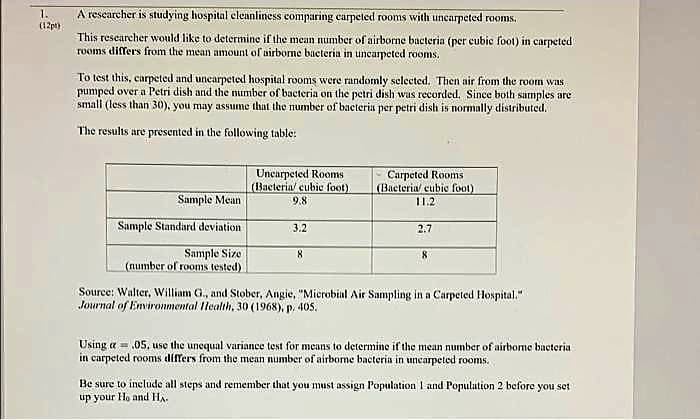1. (12pt) A researcher is studying hospital cleanliness comparing carpeted rooms with uncarpeted rooms. This researcher would like to determine if the mean number of airborne bacteria (per cubic foot) in carpeted rooms differs from the mean amount of airborne bacteria in uncarpeted rooms. To test this, carpeted and uncarpeted hospital rooms were randomly selected. Then air from the room was pumped over a Petri dish and the number of bacteria on the petri dish was recorded. Since both samples are small (less than 30), you may assume that the number of bacteria per petri dish is normally distributed. The results are presented in the following table: Uncarpeted Rooms (Bacteria/ cubic foot). 9.8 Carpeted Rooms (Bacteria/ cubic foot) 11.2 Sample Mean Sample Standard deviation 3.2 2.7 Sample Size 8 (number of rooms tested) Source: Walter, William G., and Stober, Angie, "Microbial Air Sampling in a Carpeted Hospital." Journal of Environmental Health, 30 (1968), p. 405. Using a .05, use the unequal variance test for means to determine if the mean number of airbome bacterial in carpeted rooms differs from the mean number of airborne bacteria in uncarpeted rooms. Be sure to include all steps and remember that you must assign Population 1 and Population 2 before you set up your Ho and HA
1. (12pt) A researcher is studying hospital cleanliness comparing carpeted rooms with uncarpeted rooms. This researcher would like to determine if the mean number of airborne bacteria (per cubic foot) in carpeted rooms differs from the mean amount of airborne bacteria in uncarpeted rooms. To test this, carpeted and uncarpeted hospital rooms were randomly selected. Then air from the room was pumped over a Petri dish and the number of bacteria on the petri dish was recorded. Since both samples are small (less than 30), you may assume that the number of bacteria per petri dish is normally distributed. The results are presented in the following table: Uncarpeted Rooms (Bacteria/ cubic foot). 9.8 Carpeted Rooms (Bacteria/ cubic foot) 11.2 Sample Mean Sample Standard deviation 3.2 2.7 Sample Size 8 (number of rooms tested) Source: Walter, William G., and Stober, Angie, "Microbial Air Sampling in a Carpeted Hospital." Journal of Environmental Health, 30 (1968), p. 405. Using a .05, use the unequal variance test for means to determine if the mean number of airbome bacterial in carpeted rooms differs from the mean number of airborne bacteria in uncarpeted rooms. Be sure to include all steps and remember that you must assign Population 1 and Population 2 before you set up your Ho and HA
Glencoe Algebra 1, Student Edition, 9780079039897, 0079039898, 2018
18th Edition
ISBN:9780079039897
Author:Carter
Publisher:Carter
Chapter10: Statistics
Section10.3: Measures Of Spread
Problem 1GP
Related questions
Question
See photo for question

Transcribed Image Text:A researcher is studying hospital cleanliness comparing carpeted rooms with uncarpeted rooms.
(12pt)
This researcher would like to determine if the mean number of airborne bacteria (per cubic foot) in carpeted
rooms differs from the mean amount of airborne bacteria in uncarpeted rooms.
To test this, carpeted and uncarpeted hospital rooms were randomly selected. Then air from the room was
pumped over a Petri dish and the number of bacteria on the petri dish was recorded. Since both samples are
small (less than 30), you may assume that the number of bacteria per petri dish is normally distributed.
The results are presented in the following table:
Uncarpeted Rooms
(Bacteria/ cubic foot)
9.8
Carpeted Rooms
(Bacteria/ cubic foot)
11.2
Sample Mean
Sample Standard deviation
3.2
2.7
Sample Size
8
(number of rooms tested)
Source: Walter, William G., and Stober, Angie, "Microbial Air Sampling in a Carpeted Hospital."
Journal of Environmental Health, 30 (1968), p. 405.
Using a = .05, use the unequal variance test for means to determine if the mean number of airbome bacteria
in carpeted rooms differs from the mean number of airborne bacteria in uncarpeted rooms.
Be sure to include all steps and remember that you must assign Population 1 and Population 2 before you set
up your Ho and HA.
Expert Solution
This question has been solved!
Explore an expertly crafted, step-by-step solution for a thorough understanding of key concepts.
Step by step
Solved in 4 steps with 4 images

Recommended textbooks for you

Glencoe Algebra 1, Student Edition, 9780079039897…
Algebra
ISBN:
9780079039897
Author:
Carter
Publisher:
McGraw Hill

Glencoe Algebra 1, Student Edition, 9780079039897…
Algebra
ISBN:
9780079039897
Author:
Carter
Publisher:
McGraw Hill